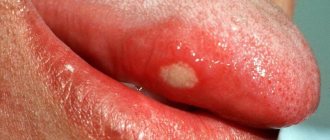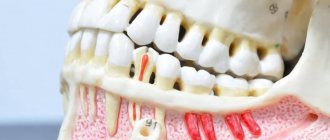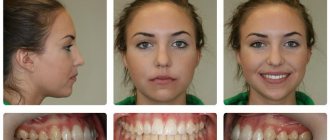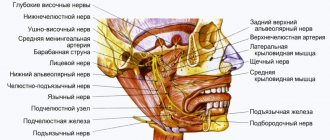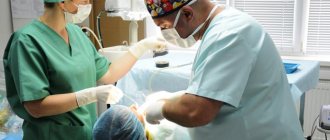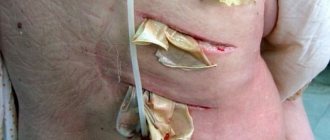Causes and pathogenesis of abscesses and phlegmons
Most purulent lesions of the maxillofacial area are odontogenic in nature. This means that the disease is formed due to the spread of infection from the inflamed root or periodontium. In such cases, streptococci and staphylococci from the primary lesion penetrate through the lymphatic vessels into the deep layers of the soft tissues of the face.
The state of immunity is of great importance in the development of the purulent process. A decrease in the body's protective abilities is a powerful predisposing factor for tissue suppuration.
Clinical picture of the disease
In the initial stages, abscesses and phlegmons adjacent to the lower jaw are manifested by compaction and progressive swelling of the soft tissues of the face. The skin over the purulent focus is often hyperemic. The key symptom of suppuration is fluctuation - the feeling of fluid in a confined space.
The course of phlegmon is accompanied by general intoxication, in which the patient presents the following complaints:
malaise and feeling of chronic fatigue; increase in body temperature; fatigue and joint pain.
Abscesses, as a rule, do not cause such symptoms due to the limited nature of the pathological process.
Abscess, phlegmon of the maxillofacial area in children is characterized by an acute and severe course of the disease. Diffuse purulent lesions of soft tissues are formed as a result of the imperfection of the children's immune system.
Opening an abscess, phlegmon of the maxillofacial area
The frequency of development of abscesses and phlegmon of the maxillofacial area of the head is due to the high prevalence of chronic focal odontogenic and tonsillogenic infections, as well as infectious and inflammatory lesions of the skin and oral mucosa. Based on data on the localization of the infectious-inflammatory process in various anatomical sections, zones, regions, as well as spaces of the head and neck, their systematization is built. From the description of the topographic-anatomical structure of the areas of the face, the perimandibular and adjacent areas of the neck, one can see the complexity of their anatomy. There are many cellular spaces, numerous lymph nodes and vessels scattered throughout all areas of the face, an abundant network of arteries and veins with rich innervation of these areas.
The basic principle of treating inflammatory diseases is opening the source of inflammation and draining it. Complete drainage reduces pain, promotes the outflow of wound fluid, improves local microcirculation, which naturally has a beneficial effect on local metabolic processes, the transition of the wound process to the regeneration phase, reducing intoxication and interstitial pressure, limiting the necrosis zone and creating unfavorable conditions for the development of microflora.
The incisional drainage method of treating phlegmons and soft tissue abscesses is quite widespread to this day. It involves opening a purulent focus and open wound management in the postoperative period. The incisional drainage method is a classic one; in general, it determines the tactics for the treatment of acute purulent diseases of soft tissues and purulent wounds.
Opening of the purulent focus is carried out by external access from the skin, or intraoral access from the mucous membrane.
During the operation of opening an abscess (phlegmon), the skin, mucous membrane, and fascial formations above the purulent focus are dissected; the muscles are cut off, peeled off from the place of attachment to the bone of the temporal, medial pterygoid and chewing muscles (m. temporalis, i.e. pterygoideus mcdialis, i.e. masseter) or using a hemostatic clamp, the muscle fibers of the temporal, mylohyoid and buccal muscles (m. temporalis) are pulled apart , T. mylohyoideus, T. buccalis). The exception is the subcutaneous muscle of the neck (m. platysma) and often the mylohyoid muscle, the fibers of which intersect in the transverse direction. which ensures the wound gapes and creates good conditions for the outflow of purulent exudate. Loose tissue located on the way to the purulent focus, in order to avoid damage to the vessels, nerves, and excretory flow of the salivary glands located in it, is stratified and pulled apart with a hemostatic clamp.
Diagnosis of the disease
Establishing a diagnosis for acute odontogenic infections includes the following measures:
Collection of medical history. The doctor finds out the patient’s complaints and the general condition of the patient. External examination of the maxillofacial area and palpation of regional lymph nodes. Most inflammatory and purulent processes cause enlargement and pain of the lymph nodes. Instrumental examination of the oral cavity, during which the doctor detects chronic foci of odontogenic infection. X-ray in frontal and lateral projection. Laboratory blood test, in which there is an increase in SOE, leukocytes and a decrease in the concentration of red blood cells and hemoglobin.
Clinical symptoms
Manifestations of the disease are determined by the location and severity. The pathology clinic is similar to periodontitis. The patient experiences intense pain that increases with palpation or biting on the affected area.
The pathology is characterized by the following symptoms:
- Dense swelling and severe hyperemia.
- Protrusion of a pathological focus from the mucous membrane of the cheeks or periodontium.
- Facial asymmetry, jaw deformation.
- The flow of pus from the fistulous passages.
- Hyperthermia during intoxication.
- Dizziness, lack of appetite, deterioration in general health.
- Allergic reactions.
Some symptoms may be absent or mild. Clinical manifestations depend on the location.
Diagnostic techniques
Initially, the doctor conducts a patient interview and a clinical examination of the oral cavity. The time of onset and nature of the symptoms are clarified. Complaints of deterioration in health, loss of appetite and other manifestations of intoxication are heard.
During the examination, the doctor visually and palpably assesses the condition of the mucous membrane in the affected area. The pain of touch, the presence of carious units, the condition of the skin in projection, the symmetry of facial features, and lymph nodes are recorded. Body temperature and pressure are measured.
If necessary, additional diagnostic measures are carried out: X-ray, ultrasound, EDI, CBC.
Based on the data received, the doctor confirms the diagnosis and draws up a treatment plan.
Schemes for eliminating the disease
An integrated approach to treating the disease is used. Surgery allows you to open and drain the source of infection. Symptomatic therapy, antibiotics, vitamins, anti-inflammatory drugs, and detoxification drugs are prescribed as additional methods. Drug therapy is limited to 1-2 weeks.
When choosing a treatment regimen, the following are taken into account:
- Features of the pathology: stage, localization, prevalence, etc.
- Age and immune status of the patient, concomitant diseases.
The main task of the dentist is to prevent the spread of infection to other organs and systems of the patient’s body.
Surgical autopsy
It is performed under local anesthesia. The operation consists of several stages:
- Opening and removing pus.
- Antiseptic wound treatment.
- Drainage, dressing.
- Daily dressings with antiseptic treatment.
After surgery, the oral cavity must undergo sanitation, treatment or extraction of the affected unit.
Potential Complications
A maxillary abscess is actually a complication of infectious diseases, trauma or caries-affected units. In the absence of timely treatment, the pathology can take dangerous and life-threatening forms: meningitis, phlegmon, mediastinitis, thrombophlebitis of the sinuses of the brain, sepsis.
General principles of treatment of the disease
The doctor who treats phlegmon of the maxillofacial area is an oral and maxillofacial surgeon.
Each doctor, when starting to treat an odontogenic process in the maxillofacial area, is guided in his actions by the following principles:
The tooth that caused the development of phlegmon is removed. Timely diagnosis is very important due to the characteristics of this area, from where the infection can spread, causing severe consequences (in particular, mediastinitis). It is necessary to eliminate the spread of the infection, that is, promptly open the lesion and eliminate the inflammatory exudate, relieve tissue tension. The rate of subsidence of inflammation depends on the quality of evacuation of all decay products from the wound, that is, careful postoperative treatment of the wound is necessary. Comprehensive treatment of pathology using all means and methods available in this medical institution. Friendly management of the patient with colleagues from other areas, timely appointment of consultations with all specialists for combined lesions. Visible external changes often occur, which are not always pleasant for the patient, which is especially painful in the face area. Therefore, there is an urgent need to organize work with patients by a medical psychologist in the early stages after surgery, especially if there is a significant visible defect. Correct stage-by-stage treatment, organization of medical rehabilitation, referral to the appropriate department with complete information about the patient. Fully informing relatives and the patient about the violation of significant functions of the maxillofacial area, if any. Upon leaving the hospital, the patient should have clear further recommendations, especially if it is necessary to continue treatment on an outpatient basis.
Symptoms of perimandibular abscess
The first sign of the formation of a perimaxillary abscess is toothache, which intensifies when biting in the affected area. Subsequently, the clinical picture of the disease is supplemented by the appearance of edema and the formation of a hyperemic, painful compaction in it. Some patients experience severe facial asymmetry.
Without treatment, the patient's condition worsens. A spontaneous opening of the abscess occurs, the bacterial flora begins to actively multiply in the oral cavity, leading to a chronic process. Chronic suppuration appears from the formed fistula canals, and intoxication of the sick person’s body with decay products is observed.
Complications of abscesses and phlegmon
Purulent lesions of the maxillofacial area can be complicated by the following pathologies:
Sepsis is a serious condition of the body that is caused by the penetration of a bacterial infection into the circulatory system. Treatment of such a complication is difficult due to the development of body resistance to antibiotic therapy. Sepsis is often the cause of death. Mediastenitis in the form of purulent inflammation of the tissue of the mediastinum, where the heart, lungs and bronchi are located. Meningitis . Inflammatory damage to the meninges develops as a result of the spread of purulent infection through the lymphatic and blood vessels of the head.
Etiology of the disease
Submandibular phlegmon develops as a result of the spread of infection from the following sources:
- odontogenic -gangrenous roots and teeth;
- intraosseous , with purulent lesions of bone tissue in the form of osteomyelitis, cysts and periostitis of the jaw;
- gingival , which involves the presence of diffuse inflammation of the gums and periodontium in the oral cavity;
- mucostomatogenic - acute or chronic inflammation of the mucous membrane of the gums and tongue;
- tonsillar-pharyngeal , which involves the spread of pathological microorganisms from the throat and pharynx.
Such a strict separation of etiological factors is necessary for a thorough diagnosis and complex therapy of a purulent disease.
Staphylococcus aureus
The direct causative agents of inflammatory processes in the soft tissues of the maxillofacial area are considered to be cocci (staphylococcus and streptococcus), which are combined with Escherichia coli. Very often, odontogenic phlegmon of the submandibular region is provoked by Staphylococcus aureus.
Forecast and prevention of the disease
The prognosis of odontogenic abscesses and phlegmons is usually favorable. A positive treatment result is observed with timely indication of full surgical care. In such cases, the patient must be hospitalized in a specialized medical hospital.
Lethal outcomes from purulent lesions of the soft tissues of the maxillofacial area are associated with late presentation of the patient and systemic suppression of his immunity.
Prevention of the disease is achieved in the following ways:
sanitation of the oral cavity, during which the dentist treats all carious, pulpitic and periodontitis teeth; strict adherence by patients to the rules of personal hygiene and regular brushing of teeth; undergoing regular preventive examinations at the dentist, at least twice a year; timely consultation with a doctor if symptoms of dental diseases are detected. Every person should remember that the cost of prevention is much lower than the cost of treatment. And in some cases, sanitation of the oral cavity can prevent the development of severe complications, which are accompanied by high mortality in patients.
Treatment of maxillary abscess
The main goal of treatment of perimandibular abscesses is the complete elimination of the infectious process and the subsequent restoration of body functions. The main activities aimed at achieving this goal include:
- following a diet with a predominance of purees and pureed soups;
- opening the abscess and draining the resulting cavity;
- antibacterial therapy;
- vitamin therapy;
- taking immunostimulants;
- detoxification therapy;
- taking analgesics;
- rinsing the mouth with solutions of furatsilin and soda.
With timely and professional treatment, the prognosis of the disease is almost always favorable. Full recovery of the patient occurs after 1.5 - 2 weeks from the date of the start of treatment in the department of dental surgery at Adent.
